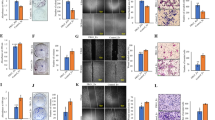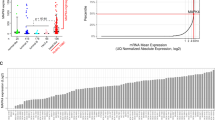Abstract
Basal-like breast cancer (BLBC) is a malignant carcinoma with aggressive motility and rapid growth. Accounting for 15% of breast cancers, BLBC often exhibits a poor prognosis and tends to metastasize to the brain and lungs. Because most BLBC display a triple-negative phenotype (ER-, PR-, and HER2-), conventional cytotoxic chemotherapy remains the only treatment option despite poor success and high rate of relapse. The overexpression of the forkhead-box transcription factor C1 (FOXC1) was recently identified as a biomarker of BLBC. Increased expression of FOXC1 was linked to excessive mobility and growth of BLBC cell lines, suggesting FOXC1 as a therapeutic target. In this study, siRNA-mediated knockdown of FOXC1 was confirmed to decrease the proliferation rate, migration, and invasion in a model BLBC-like cell line (4T1). 4T1 and 4T1-∆FOXC1 cells lacking FOXC1 expression (generated by CRISPR/Cas9) were used to evaluate the effects of FOXC1 expression in an orthotopic murine model of BLBC. No statistically significant difference in tumor volume was observed between 4T1 and 4T1-∆FOXC1 tumors. Furthermore, tumors metastasized to the liver and lungs to a similar degree regardless of FOXC1 expression. These data suggest that, despite positive results in vitro, FOXC1 may not be a promising therapeutic target for BLBC.
This is a preview of subscription content, access via your institution
Access options
Subscribe to this journal
Receive 12 print issues and online access
$259.00 per year
only $21.58 per issue
Buy this article
- Purchase on Springer Link
- Instant access to full article PDF
Prices may be subject to local taxes which are calculated during checkout








Similar content being viewed by others
References
Badve S, Dabbs DJ, Schnitt SJ, Baehner FL, Decker T, Eusebi V, et al. Basal-like and triple-negative breast cancers: a critical review with an emphasis on the implications for pathologists and oncologists. Mod Pathol. 2011;24:157–67.
Kreike B, van Kouwenhove M, Horlings H, Weigelt B, Peterse H, Bartelink H, et al. Gene expression profiling and histopathological characterization of triple-negative/basal-like breast carcinomas. Breast Cancer Res. 2007;9:R65.
Smid M, Wang Y, Zhang Y, Sieuwerts AM, Yu J, Klijn JGM, et al. Subtypes of breast cancer show preferential site of relapse. Cancer Res. 2008;68:3108–14.
Seewaldt VL, Scott V. Rapid progression of basal-type breast cancer. New Engl J Med. 2007;356:e12.
Sarrio D, Rodriguez-Pinilla SM, Hardisson D, Cano A, Moreno-Bueno G, Palacios J. Epithelial-mesenchymal transition in breast cancer relates to the basal-like phenotype. Cancer Res. 2008;68:989–97.
Rakha EA, Reis-Filho JS, Ellis IO. Basal-like breast cancer: a critical review. J Clin Oncol. 2008;26:2568–81.
Ray PS, Wang J, Qu Y, Sim MS, Shamonki J, Bagaria SP, et al. FOXC1 is a potential prognostic biomarker with functional significance in basal-like breast cancer. Cancer Res. 2010;70:3870–6. (Journal Article)
Wang J, Ray PS, Sim MS, Zhou XZ, Lu KP, Lee AV, et al. FOXC1 regulates the functions of human basal-like breast cancer cells by activating NF-kB signaling. Oncogene. 2012;31:4798–802.
Biswas DK, Iglehart JD. Linkage between EGFR family receptors and nuclear factor kappaB (NF-κB) signaling in breast cancer. J Cell Physiol. 2006;209:645–52.
Bloushtain-Qimron N, Yao J, Snyder EL, Shipitsin M, Campbell LL, Mani SA, et al. Cell type-specific DNA methylation patterns in the human breast. Proc Natl Acad Sci USA. 2008;105:14076–81.
Hu P, Chen X, Sun J, Bie P, Zhang LD. siRNA-mediated knockdown against NUF2 suppresses pancreatic cancer proliferation in vitro and in vivo. Biosci Rep. 2015;35:1.
Song N, Wang Y, Gu X, Chen Z, Shi L. Effect of siRNA-mediated knockdown of eIF3c gene on survival of colon cancer cells. J Zhejiang Univ Sci B. 2013;14:451–9.
Bee A, Brewer D, Beesley C, Dodson A, Forootan S, Dickinson T, et al. siRNA knockdown of ribosomal protein gene RPL19 abrogates the aggressive phenotype of human prostate cancer. PLoS One. 2011;6:e22672.
Guzman-Villanueva D, El-sherbiny IM, Herrera-Ruiz D, Vlassov AV, Smyth HDC. Formulation approaches to short interfering RNA and microrna: challenges and implications. J Pharm Sci. 2012;101:4046–66.
Kaur P, Nagaraja GM, Zheng H, Gizachew D, Galukande M, Krishnan S, et al. A mouse model for triple-negative breast cancer tumor-initiating cells (TNBC-TICs) exhibits similar aggressive phenotype to the human disease. BMC Cancer. 2012;12:120.
Sander JD, Joung JK. CRISPR-Cas systems for editing, regulating and targeting genomes. Nat Biotechnol. 2014;32:347–55.
Yin H, Kanasty RL, Eltoukhy AA, Vegas AJ, Dorkin JR, Anderson DG. Non-viral vectors for gene-based therapy. Nat Rev Genet. 2014;15:541–55.
Wang J, Lu Z, Wientjes MG, Au JL. Delivery of siRNA therapeutics: barriers and carriers. AAPS J. 2010;12:492–503.
Aleku M, Schulz P, Keil O, Santel A, Schaeper U, Dieckhoff B, et al. Atu027, a liposomal small interfering RNA formulation targeting protein kinase N3, inhibits cancer progression. Cancer Res. 2008;68:9788–98.
Davis ME, Zuckerman JE, Choi CHJ, Seligson D, Tolcher A, Alabi CA, et al. Evidence of RNAi in humans from systemically administered siRNA via targeted nanoparticles. Nature. 2010;464:1067–70.
Acknowledgements
This work was supported by start-up funds to DWP by the University of Kentucky.
Author information
Authors and Affiliations
Corresponding author
Ethics declarations
Conflict of interest
The authors declare that they have no conflict of interest.
Rights and permissions
About this article
Cite this article
Mott, L., Su, K. & Pack, D.W. Evaluation of FOXC1 as a therapeutic target for basal-like breast cancer. Cancer Gene Ther 25, 84–91 (2018). https://doi.org/10.1038/s41417-018-0010-9
Received:
Revised:
Accepted:
Published:
Issue Date:
DOI: https://doi.org/10.1038/s41417-018-0010-9



